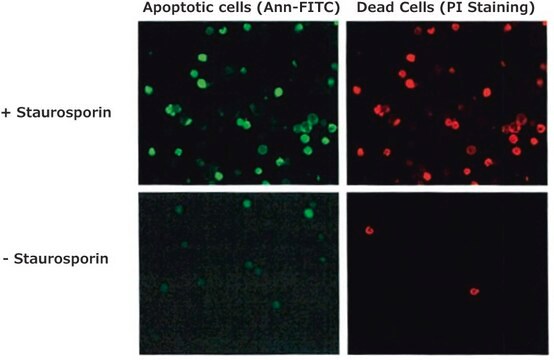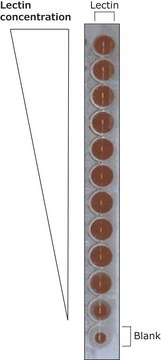A9460
Annexin V from human placenta
≥90% (SDS-PAGE), buffered aqueous solution
Sinónimos:
Annexin V, Calphosbindin I, Lipocortin V, PAP-1
About This Item
Productos recomendados
origen biológico
human placenta
Nivel de calidad
Ensayo
≥90% (SDS-PAGE)
Formulario
buffered aqueous solution
mol peso
33 kDa (four subunits)
técnicas
cell based assay: suitable
impurezas
Human Source(HCV), tested negative
solubilidad
water: soluble
idoneidad
suitable for molecular biology
Nº de acceso UniProt
Condiciones de envío
dry ice
temp. de almacenamiento
−70°C
Información sobre el gen
human ... ANXA5(308)
¿Está buscando productos similares? Visita Guía de comparación de productos
Descripción general
Annexin V is a calcium-dependent phospholipid-binding protein. It is expressed in high concentration in cells with barrier functions, such as vascular endothelium, epithelial cells in bile ducts, placental trophoblasts, mammary ducts, renal tubules, and nasal epithelium.
Aplicación
- to verify the involvement of phosphatidylserine in adhesion using flow cytometry
- to test adhesion specificity of phosphatidylserine
- for synthesis of NIR700-Annexin-V imaging probe
- in dynamic light scattering (DLS) assay to test the effects of various treatments on virion aggregation
Acciones bioquímicas o fisiológicas
Envase
Forma física
Código de clase de almacenamiento
12 - Non Combustible Liquids
Clase de riesgo para el agua (WGK)
WGK 2
Punto de inflamabilidad (°F)
Not applicable
Punto de inflamabilidad (°C)
Not applicable
Elija entre una de las versiones más recientes:
¿Ya tiene este producto?
Encuentre la documentación para los productos que ha comprado recientemente en la Biblioteca de documentos.
Los clientes también vieron
Nuestro equipo de científicos tiene experiencia en todas las áreas de investigación: Ciencias de la vida, Ciencia de los materiales, Síntesis química, Cromatografía, Analítica y muchas otras.
Póngase en contacto con el Servicio técnico





